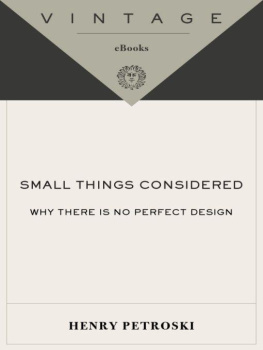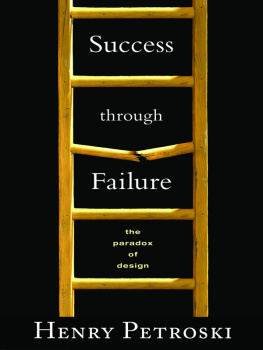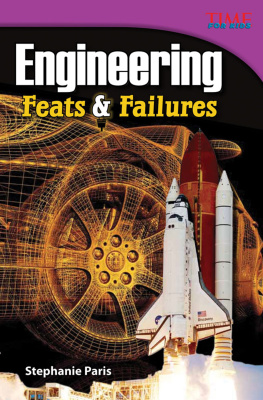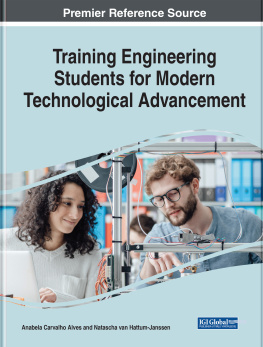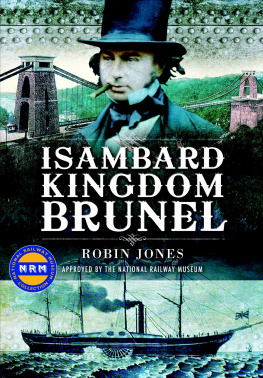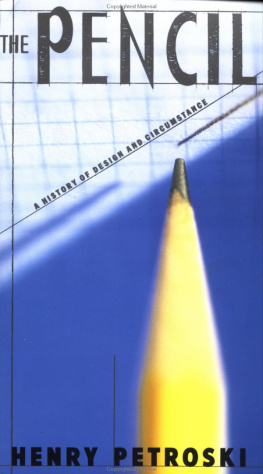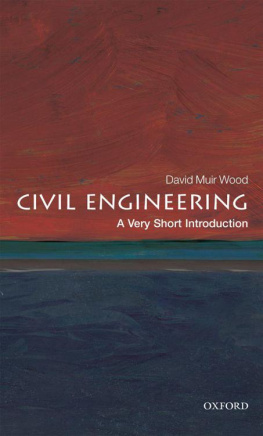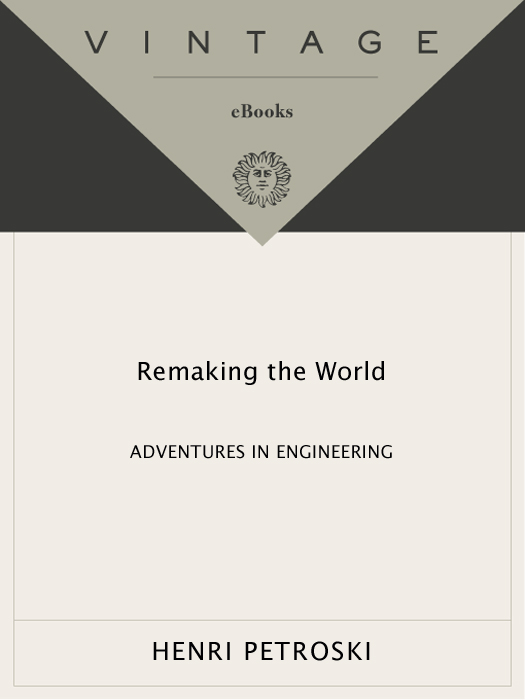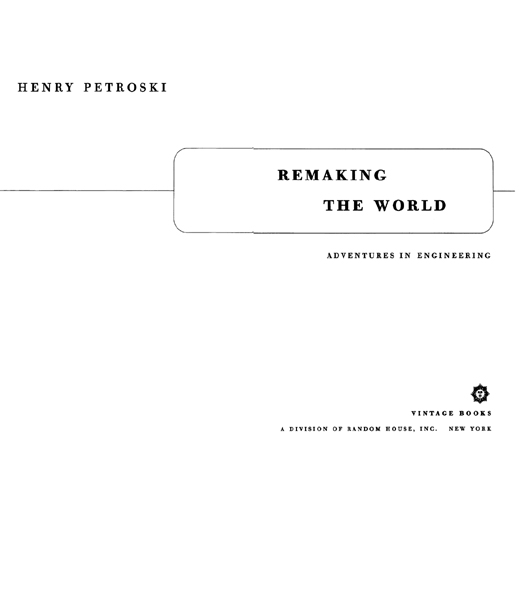Highly readable. What Petroski does best is to make civil engineering understandable to a general audience. This book is guaranteed to make any reader appreciate the work these creative professionals do for us all.
Rocky Mountain News
One lays this book down with a renewed appreciation for the work of all these men and women of progress, and for the grace and insight of the writer who tells their stories so well.
The Sciences
[Remaking the World] is a great introduction to the world of engineering and an education that ensures you will never regard the house in which you live, the roads upon which you travel or the technology with which you work in the same ways again.
Post & Courier (South Carolina)
A rewarding read the books charm lies in the countless anecdotes and bits of historic and engineering trivia that pepper each essay, rich details guaranteed to stay with you.
Forbes
ALSO BY HENRY PETROSKI
Invention by Design
Engineers of Dreams
Design Paradigms
The Evolution of Useful Things
The Pencil
Beyond Engineering
To Engineer Is Human
HENRY PETROSKI
REMAKING THE WORLD
Henry Petroski is the Aleksandar S. Vesi Professor of Civil Engineering and Professor of History at Duke University, where he also serves as chairman of the Department of Civil and Environmental Engineering. He is the author of seven previous books.
FIRST VINTAGE BOOKS EDITION, JANUARY 1999
Copyright 1997 by Henry Petroski
All rights reserved under International and Pan-American Copyright Conventions. Published in the United States by Vintage Books, a division of Random House, Inc., New York, and simultaneously in Canada by Random House of Canada Limited, Toronto. Originally published in hardcover in the United States by Alfred A. Knopf, Inc., New York, in 1997.
Most of the essays in this volume were originally published, sometimes in slightly different form, in American Scientist.
The Library of Congress has cataloged
the Knopf edition as follows:
Petroski, Henry.
Remaking the world: adventures in engineering / by Henry Petroski.
p. cm.
eISBN: 978-0-307-77320-3
I. Engineering. I. Title.
TA145.P47 1997
620-dc21 97-29328 CIP
Author photograph Catherine Petroski
www.randomhouse.com
v3.1
TO MY SISTER, MARIANNE
The scientist seeks to understand what is; the engineer seeks to create what never was.
attributed to Theodore von Krmn
Contents
Preface
In 1986 Sigma Xi, The Scientific Research Society celebrated the centennial of its founding as an honorary society for scientists and engineers, somewhat akin to Phi Beta Kappa. Today the organization of some ninety thousand members fosters interaction among science, technology, and society, encourages the appreciation and support of original work in science and technology, and honors research accomplishments. As part of the centennial, the Board of Directors of Sigma Xi began to look to its second century, and it was decided that a relocation of its headquarters from New Haven, Connecticut, was in the best interests of the society.
The move was completed early in 1990, and it brought the editorial offices of American Scientist, Sigma Xis bimonthly magazine, to Research Triangle Park, North Carolina, where its new editor, Brian Hayes, assembled a new editorial staff. At that time Brian wrote to me that he was looking to broaden the coverage of engineering and technology in the magazine, and he asked if I might send him some material for consideration. I did send him a couple of essays that I had been working on, and he then approached me with the proposition of writing a regular engineering column. I agreed to do so, and this book is by and large a selection from the three dozen or so columns I have now written for American Scientist, along with three essays first published elsewhere, and in some cases with material restored that originally had to be cut because of length restrictions in the magazine.
I am grateful to Brian Hayes for giving me the opportunity to write for American Scientist. I am also grateful to Rosalind Reid, Brians successor as editor of the magazine, to Mike May, and to David Schoonmaker for their helpful and sensitive editing of my manuscripts and for locating and selecting the illustrations that have accompanied almost all of them. Indeed, it has been a pleasure to work with the entire staff of American Scientist in the course of seeing each manuscript through the press. It has also been a pleasure to work once again with Ashbel Green, who helped select the essays included here, and with Jennifer Bernstein, Melvin Rosenthal, and others at Alfred A. Knopf involved with editing, designing, and producing this book. And, as always, I am thankful to the many librarians at Duke University and elsewhere who secured essential materials for me, sometimes under the urgency of deadlines that come with a regular publishing schedule.
Among the joys of publishing in a magazine that is read by a widely diverse group of people is the feedback that comes as each issue appears. I am grateful to my many colleagues at Duke and elsewhere who have commented on the columns and who have encouraged me to continue to write them. There has also been a steady stream of mail from new and increasingly familiar readers that expands on and often adds their own personal experiences to what I have written. I am grateful for the many helpful and interesting letters from these readers, but there have been too many of them for me to acknowledge individually here. Where I have incorporated their information into these revised and amplified versions of the columns, I have expressed my gratitude for their contributions in the Bibliography and Acknowledgments section at the back of this book. In some cases I have also elaborated there on aspects of a topic that have seemed too tangential to insert into the essay proper. In all cases I have noted the date of first appearance of an essay and have listed my principal sources for quotations and information.
Finally, and as always, I am grateful to my family. My son, Stephen Petroski, helped me by extracting information from the files of my old columns. My daughter, Karen Petroski, has been an excellent sounding board. And my wife, Catherine Petroski, has been a faithful first reader of all of these columns, even as she has been engaged in her own research and writing.
Durham, North Carolina
May 1997
W hen I was an engineering student, a friend of a friend nicknamed me Steinmetz and refused to call me by any other name. This person, whose inclinations I recall to have been toward business and politics and not at all toward science and technology, had learned from his parents that Charles Steinmetz was the embodiment of American engineering. Until I became his namesake, however, I had not heard of Steinmetz. At first I bristled at being called by a name I did not recognize, but when I was told that Steinmetz had been a famous engineer who gave great lectures that had enraptured audiences, I was flattered and enjoyed the sobriquet. That friend and I went our separate ways, and many more years passed before I learned more about Steinmetz and understood why, to so many Americanseven those who knew little about technologyhis name came to be synonymous with engineering.



